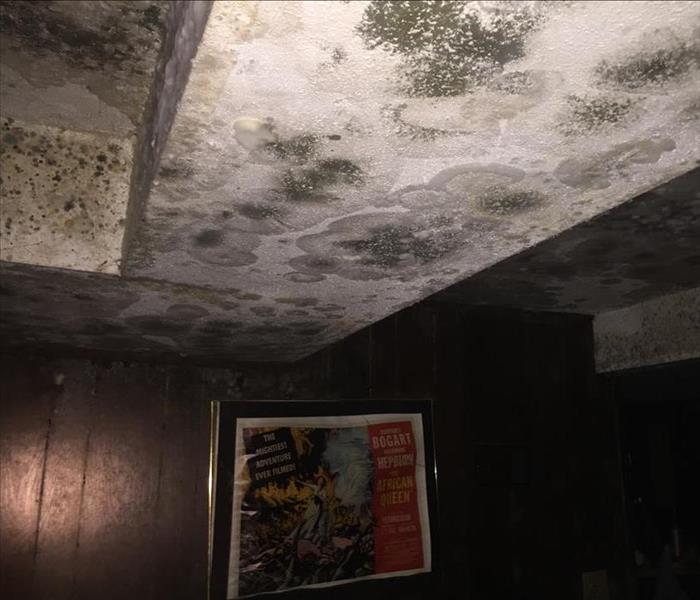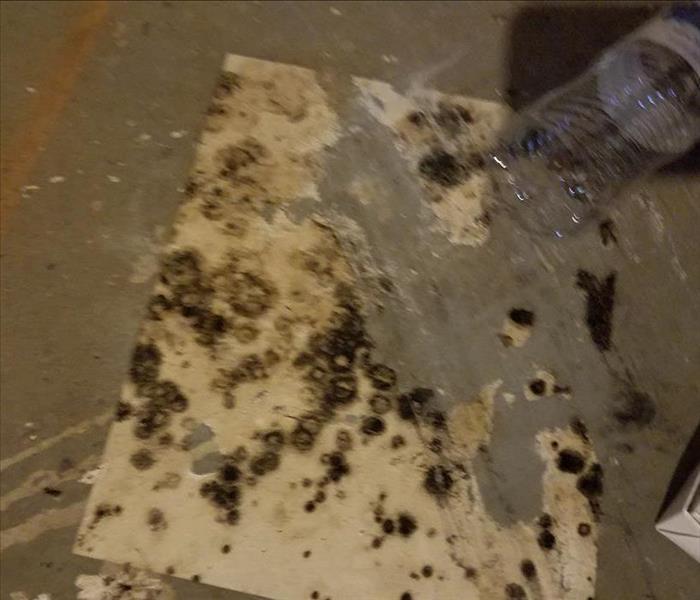Recent Mold Remediation Posts
Mold Damage Caused by Water Leaks
8/7/2019 (Permalink)
Water Leaks Can Cause Mold
A leaky faucet in your home can be very annoying, but it has the potential to be much more than an annoyance. The moisture caused by leaks can make your home into the perfect environment for mold growth. Mold spores may cause health effects and can grow rapidly if you fail to notice a leak shortly after it starts, especially in humid climates. Knowing the risks that mold presents and quickly fixing your water leaks can help to protect your home from mold growth.
About Mold Growth
Mold growth will begin in areas of your home that are wet. The mold spores will land on moist surfaces and then start to germinate. The materials on which mold can grow include:
• Sheetrock
• Tile
• Painted surfaces
• Carpet
• Wood
Indications of Mold Growth Due to Water Leaks
If you see black and white spots in the area of the leak, this is a sign that you have mold. Kitchens and basements are some of the areas in your home where there is a high risk of mold growth as these areas are prone to leaks. Therefore, it is important that you properly maintain your plumbing fixtures.
Preventing Mold Growth after Fixing Leaks
If you discover a water leak, have it fixed as soon as possible to minimize the potential for mold growth. After the leak has been fixed, use a mild detergent to wash the area and then allow it to dry completely. After it has dried, thoroughly wipe the area with bleach to kill any spores present. Boric acid is also effective at killing mold spores and can be used as a substitute for bleach. Be sure to keep kids and pets out of the area while handling chemicals.
Get Professional Assistance
If there is a part of your home that is prone to water leaks, contact a plumber. If there are hidden problems that are causing leaks to recur, you may not be able to find them yourself. A licensed plumber who is experienced at finding and fixing leaks will be better able to find and fix the issues. Your plumber will also be able to advise you on how to maintain your plumbing to prevent water leaks and mold growth in the future.
Understanding Mold
Microscopic mold spores exist almost everywhere, outdoors and indoors, making it impossible to remove all molds from a home or business. Some restoration businesses advertise “mold removal” and even guarantee to remove all mold, which is a fallacy. Consider the following mold facts:
- Mold is present almost everywhere, indoors and outdoors.
- Mold spores are microscopic and float along in the air and may enter your home through windows, doors, or AC/heating systems or even hitch a ride indoors on your clothing or a pet.
- Mold spores thrive on moisture. Mold spores can quickly grow into colonies when exposed to water. These colonies may produce allergens and irritants.
- Before mold remediation can begin, any sources of water or moisture must be addressed. Otherwise, the mold may return.
- Mold often produces a strong, musty odor and can lead you to possible mold problem areas.
- Even higher-than-normal indoor humidity can support mold growth. Keep indoor humidity below 45 percent.
Remember, if disaster does strike, SERVPRO of Springfield, Sangamon, Morgan, Cass, Macoupin, Montgomery Counties is Here to Help! Give us a call 24/7 at 217-528-7775.
Avoiding Mold in Your Household Appliances
11/10/2018 (Permalink)
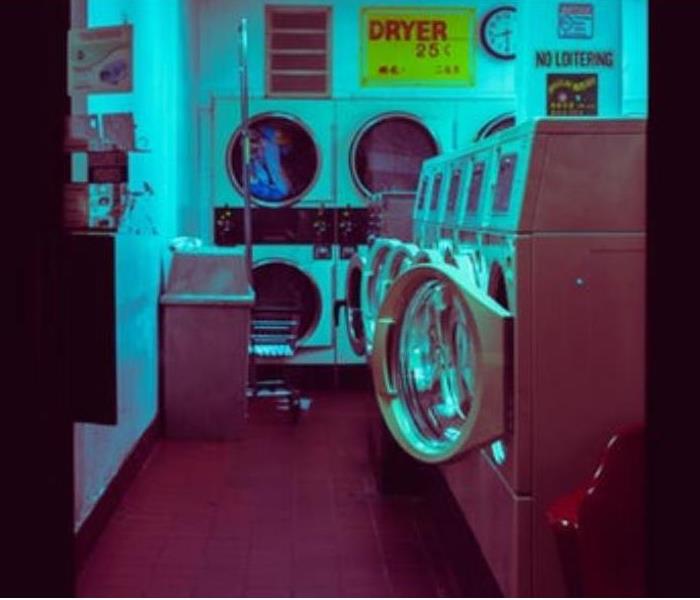 Propping doors open after a cycle will allow the machine to dry.
Propping doors open after a cycle will allow the machine to dry.
Moisture has the potential to lead to mold and many of our household appliances work with water. If there is poor ventilation, leaks or a clogged drain, your washer, dishwasher and fridge all become susceptible to mold growth.
Here are some tips to help you stay in control of your appliances.
- Front load washers have two places that mold can grow: the detergent drawer and door seal. Make sure that you leave the door and drawer open when not in use and never let laundry sit!
- Top load washers can develop mold between the drum and interior walls. Run a Clean Washer Cycle once a month if your washer has one, do not use too much detergent with your laundry and leave the lid open after each use.
- Refrigerators can grow mold between the door seals and on neglected food. Clean spills immediately and wipe down with vinegar once a month.
- Dishwashers develop mold in the filter, silverware basket, interior panels and door gasket. Use the heat-dry function and leave the door open for awhile after use.
Taking proactive steps to prevent mold growth will lengthen the life of your appliances and keep your home healthy. Remember SERVPRO® of Springfield is Here to Help!® We are available 24/7 at 217-528-7775.
Mold in the Ductwork
9/12/2018 (Permalink)
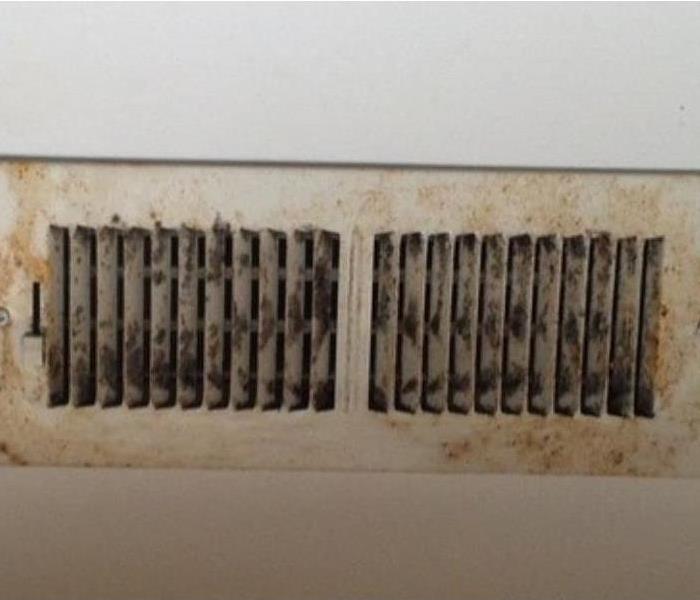 Visible mold on a vent.
Visible mold on a vent.
We at SERVPRO® of Springfield know that mold and mildew can be pesky troublemakers for any homeowner. Since all they need is moisture and a source of nutrients, they can quickly start to grow on almost any surface. One location that is often neglected as a potential “hotbed” for mold growth is the ductwork of a home. The ductwork of the HVAC system interconnects the entire home. Any place where moisture may have gotten in, mold can grow and, as a result, spread quickly throughout the system.
It is a good idea to regularly check your HVAC system to ensure that mold has not developed. By performing routine checks on the drain pan and condensate line to ensure they are not plugged and that other components such as blowers and air handlers are free from moisture, you can help avoid mold growth. If during one of these routine checks, you come across mold or mildew, remember there is a local team of remediation specialists who can help.
No matter when disaster strikes, SERVPRO® of Springfield is here to help at 217-528-7775. #mold #remediation #waterdamage #HeretoHelp #local #SERVPRO #Springfield #Illinois
Preventing Mold in the Laundry Room
8/24/2018 (Permalink)
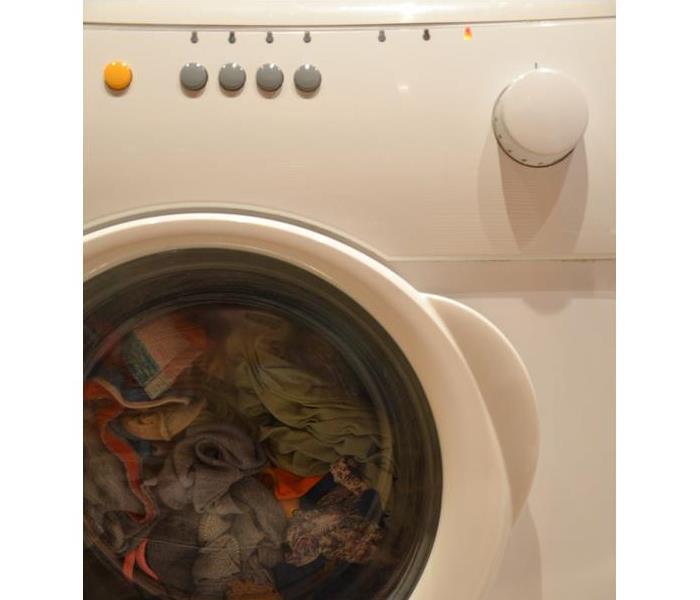 Dry wet clothes quickly to prevent mold!
Dry wet clothes quickly to prevent mold!
While mold can grow anywhere, SERVPRO® of Springfield knows that some areas of your home are more prone to mold growth than others. The laundry room is one of those spaces. Between the humidity from the dryer, the damp laundry and the potential for water leaks, a mold infestation can spread quickly in the laundry room. The best way to prevent a problem from occurring is to make a regular routine of checking for damage and taking steps to eliminate moisture.
Check for Water Damage
Regularly check pipes for leaks and the drywall around the pipes for signs of moisture. If there is any noticeable water, address the issues immediately.
Clean Appliances
Check the owner’s manual for the recommended way to clean and care for your washer and dryer. Both appliances will need to be cleaned regularly along the inside and the seals. Regular maintenance will keep your appliances running well and prevent issues with leaks and humidity levels.
Don’t Let Damp Laundry Sit
Wash and dry damp clothes as soon as possible. The inside of the washer is a prime place for mold to grow. Do not let clothes sit.
Use a Dehumidifier
Place a dehumidifier in the laundry room to keep humidity levels low.
If you do notice mold within your home and would like to have it remediated, please call SERVPRO® of Springfield at 217-528-7775. We are available 24 hours a day, 7 days a week!
Getting Ahead of Mold with SERVPRO® of Springfield
8/16/2018 (Permalink)
 Getting ahead of mold!
Getting ahead of mold!
Outdoors, mold growth is a natural part of the cycle of decomposition, but indoors mold spores can grow and develop in enclosed environments and not only cause damage to homes but has the potential to produce allergens and irritants. Mold spores usually grow in moisture filled environments and the longer they are left to grow, the more damage they can cause.
The best way to prevent a mold issue in your home or business is to ensure that moisture is contained. Frequently check plumbing, appliances, basements, bathrooms and along windows and doors is a great place to start. Making sure there are no leaks and checking for current damage is a great habit to get into for prevention. If mold is found, contact a professional immediately. It is important that mold is handled appropriately in order to ensure safety and to prevent further damage.
SERVPRO® of Springfield has a a crew trained in mold remediation. Call us today and let us help you! We can be reached 24/7 at (217) 528-7775.
Mold Do's & Don'ts
8/10/2018 (Permalink)
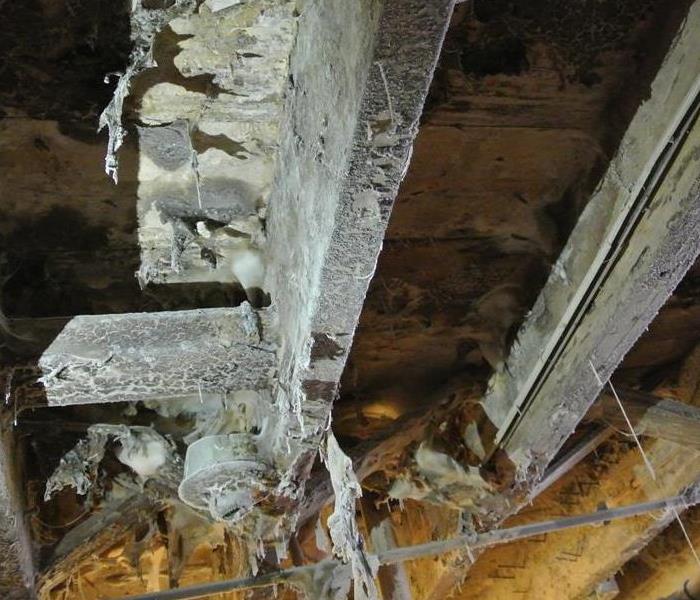 Mold in the basement of a local residence.
Mold in the basement of a local residence.
SERVPRO® of Springfield specializes in mold cleanup and restoration. Mold spores are everywhere as they are naturally occurring. They generally do not cause a problem unless they attach to a surface and grow. If you notice mold growth in your home or business there are certain things you can do to get the remediation process started.
What to Do:
- Stay out of affected areas.
- Turn off the HVAC system and fans.
- Contact SERVPRO® of Springfield for mold remediation services.
What Not to Do:
- Don’t touch or disturb the mold.
- Don’t blow air across any surfaces with visible or suspected mold growth.
- Don’t attempt to dry the area yourself.
- Don’t spray bleach or other disinfectants on the mold.
About Our Mold Remediation Services
Our crews are highly trained restoration professionals that use specialized equipment and techniques to properly remediate your mold problem quickly and safely. Give us a call at 217-528-7775 24/7. We are here to help.
Keeping Mold out of Your Carpet with SERVPRO® of Springfield
7/25/2018 (Permalink)
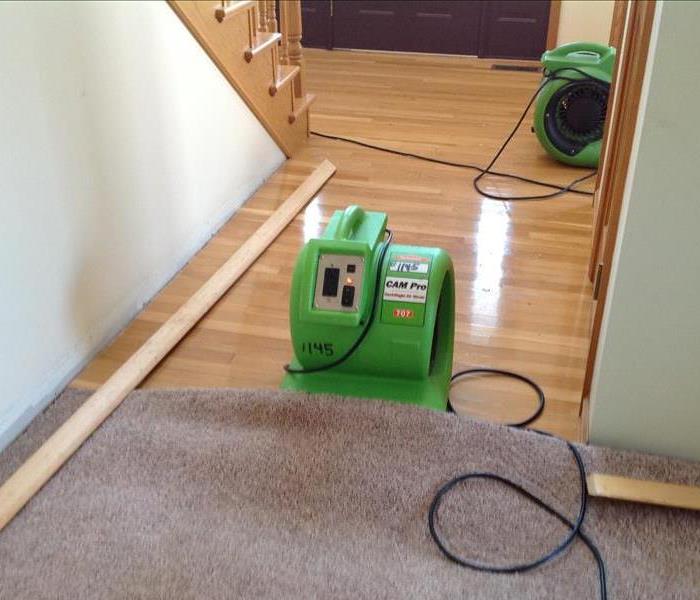 Completely drying your carpet after a water damage is key to avoiding mold!
Completely drying your carpet after a water damage is key to avoiding mold!
Your local mold remediation and carpet cleaning technicians at SERVPRO® of Springfield would like to talk about mold in your carpets. Did you know that once carpet becomes wet, mold can set in? The moisture can cause mold to grow and spread in as little as 48 hours. Once a carpet has become wet it is imperative to dry and clean it as quickly as possible. If all of the moisture is not removed and mold begins to grow, an odor or stain may appear. If this happens, it is important to have the area remediated by professionals as quickly as possible in order to avoid putting anyone at risk for health related issues.
Once the area has been remediated, future problems can be avoided by keeping carpet out of high-humidity areas. Basements, bathrooms, kitchens and laundry rooms are better with a sealed tile as opposed to carpet!
If you have any questions regarding possible mold growth in your carpet, contact SERVPRO® of Springfield at 217-528-7775.
Avoid a Moldy Bathroom with Tips from SERVPRO® of Springfield
6/11/2018 (Permalink)
 Mold damage can be prevented!
Mold damage can be prevented!
SERVPRO® of Springfield is ready to help you be proactive in the battle against mold. Did you know that the bathroom is one of the most common indoor areas for mold growth? The lingering moisture created by showers and baths can leave behind mold that can leave you feeling less than clean.
Below are a few simple steps to prevent mold in your bathroom:
- Properly ventilate your bathroom. If you have a fan, make sure it is on or open a window while you shower or take a bath.
- After you are finished, allow the fan to run for at least 30 minutes to allow air to circulate.
- Use mildew-resistant shower and window curtains.
- Wipe down your shower after use to remove any lingering moisture.
- Once a month, wash your shower curtain.
- Remove damp laundry from the floor
- If you notice any leaks, get them repaired ASAP.
If you suspect mold in your bathroom or any other room of your home, call SERVPRO® of Springfield at 217-528-7775. We are here to help 24/7.
Springfield, IL Mold Damage Remediation Experts
4/26/2018 (Permalink)
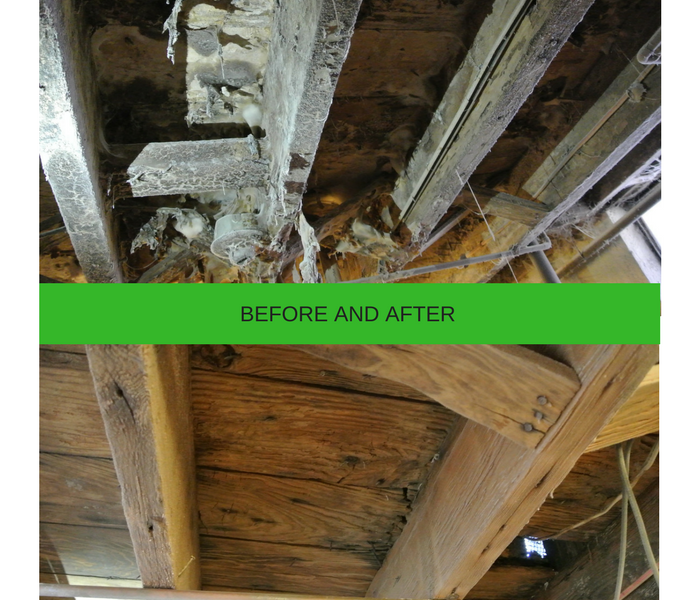 Before and After of a Local Springfield Basement
Before and After of a Local Springfield Basement
The impact of mold on a home can be overwhelming. The thought that a microscopic spore needs just a small amount of continuous moisture to grow into a living, growing force is almost unimaginable. However, that is often the case for mold that has been left to its own devices in a home or business. As can be seen from the before photos of a home in Springfield, IL, once mold gets growing, it can take over a space of nearly any size.
Thankfully there is help available for mold remediation. One of the tried and true methods that SERVPRO® of Springfield utilizes is called Sodablasting. Our Sodablasting technicians utilize a self-contained system that includes a blast generator, high pressure compressed air, a moisture decontamination system and a blast hose and nozzle. The system propels baking soda at a high rate to strip mold off of different types of surfaces while cleaning and deodorizing.
While this method is highly effective, it does leave behind a lot of material that will need to be cleaned up and this should be factored into the decision making process when choosing a form of remediation. Remember timing is everything when it comes to staying on top of a moisture and mold problem. SERVPRO® of Springfield’s mold remediation specialists are here 24/7 to help you. Please call us at 217-528-7775 so we can help make it “Like it never even happened.”
Air Filtration
9/18/2017 (Permalink)
The goal of every restoration job is to safely and efficiently return the indoor environment to preloss condition for the customer. Part of this responsibility is to address the quality of the air inside the structure.
Any job that involves cleanup of sewage, mold, and/or fire damage will generate significant amounts of particulates and odiferous (smelly) gases. These contaminants are a direct result of the damage itself, as well as the necessary process of treating and cleaning damaged materials. This includes not only damage in the occupied space, but also contaminants in wall or ceiling cavities that may be disturbed and unknowingly introduced into the occupied space. These contaminants can settle on carpet, upholstery, furnishings, and be drawn into the HVAC system.
Because these particles can be easily stirred up and become airborne we usually employ the use of an air scrubber in some capacity. In the simplest terms, an air scrubber is a portable filtration system. It draws in air from the surrounding environment and passes it through a series of filters. These filters efficiently remove particles from the air to help improve indoor air quality.
-Source: Dri-Eaz
Mold Remediation
9/18/2017 (Permalink)
"Mold, often referred to as fungi, are primarily recognized as hazards, however, there are molds with important applications and can serve useful purposes in our environment. Molds are a key component of foods we enjoy, (red wine, beer, mushrooms, and blue cheese). Molds produce by-products that are used in the manufacture of many medications such as antibiotics and anti-rejection drugs for organ transplant patients. Molds are necessary to complete the process that break down organic waste in our landfills and compost bins."
- Source:"IICRC Approved Applied Microbial Remediation Technician Course Manual"
Despite the above passage, the mold that has become a large concern in recent years are those types that cause adverse health effects. It is for these reasons that an indoor environmental professional such as a mold remediation technician is usually employed to correct the problem in order to restore a positive living environment for the inhabitants of the structure.
If you have a mold problem contact SERVPRO of Springfield at 217-528-7775
Factors that Affect Mold Growth
9/18/2017 (Permalink)
There are 6 general factors that affect mold growth:
- Temperature
- Light
- pH
- Nutrients
- Oxygen
- Water
Of these factors the easiest to control by far are the presence of water and nutrients. For this reason almost all remediation projects include some component of structure drying (removing water) of source removal (removing nutrients).
Structure drying could include the implementation of dehumidifiers to remove moisture from the air or the use of air scrubbers to filter air and draw moisture out of material through evaporation.
Source removal is usually some kind of controlled removal of building materials that are easier and more cost effectively removed and than cleaned in order to restore the structure to its original state. It is very important that the removal of material be controlled in order to limit the spread of the affected area throughout the structure.
If you need help controlling these factors call SERVPRO of Springfield today at 217-528-7775
Mold Loves Damp Places
8/22/2017 (Permalink)
What Does Mold Need to Grow?
According to Michael Pugliese, author of The Homeowner’s Guide to Mold, there are three main necessities that mold spores need to grow and thrive:
Mold spores need moist or damp areas to grow and reproduce. Watch for flooding, leaky pipes or windows, etc. Also excess moisture in the bathrooms, kitchens, and laundry rooms are prime areas for mold growth.
Mold spores need food – in the literal sense as well as other materials (i.e. cotton, leather, wood, paper products and others). The most dangerous materials mold loves to grow on, are porous materials (beds, couches etc). Its often impossible to remove mold growth from these items.
Mold spores thrive in temperatures 32 and 120 degrees Fahrenheit. Temperatures from about 70 – 90 degrees are the most conducive for mold growth. Chances of mold growth are heightened greatly between those temperatures. You may be wondering why mold can grow in your freezer. Mold doesn’t die when temperatures drop below 32 degrees, they lay dormant until temperatures raise, or they are set out to warm up.
Favorable Conditions for Mold
Michael Pugliese, author of the same book previously mentioned, also offers 5 tips describing favorable or unfavorable conditions for mold growth:
- A relative Humidity of roughly 50% or higher
A good preventative measure would be to purchase a hygrometer to measure humidity levels in your home.
Avoid developing piles of rags, clothing or other mold food sources.
This explains why overly “tight” homes designed for energy efficiency can have mold problems.
Unfavorable Conditions for Mold
Good circulation throughout the home is important to eliminate dampness or potential moisture; especially in attics, basements, crawlspaces, laundry rooms.
Make sure to keep your home’s relative humidity down below 50%.
-Source: Mold Blogger
5 Principles of Mold Remediation
8/17/2017 (Permalink)
SERVPRO of Springfield is certified by the Institute of Inspection Cleaning and Restoraction Certification (IICRC) for water, and fire restoration as well as microbial remediation. The IICRC outlines five major principles of mold remediation.
- Make sure safety and health precautions are taken by cleanup professionals and occupants. Mold-contaminated buildings can be associated with a number of health problems. Anyone involved in the mold remediation process must be protected from exposure through a combination of practices and controls.
- A post-cleanup assessment by an independent environmental expert. An effective mold remediation cannot be developed without first determining the extent of the contamination to be removed. To ensure that remediation work is being properly performed, it is highly recommended that appropriate documentation of the remediation process be kept by project management
- Control of mold before it spreads further. Eliminating mold at the source of contamination is essential. Once mold spores spread through the air, it will be much more difficult to capture.
- Oversee the proper physical removal of the mold. The mold must be physically removed from the structure. Attempts to isolate mold or remove signs of mold on the surface are not adequate. Note that bleach alone cannot kill mold.
- Ensure that moisture is controlled to limit future contamination or recontamination. Mold growth is virtually inevitable if moisture is not controlled. Moisture problems must be identified, located and corrected or controlled as soon as possible.
Application of these principles may involve multiple disciplines and professionals from a wide range of restoration and indoor environmental fields.
-Source: IICRC
If you suspect mold contamination in your home or business contact SERVPRO of Springfield today at 217-528-7775
Performing the right process for remediation
7/27/2017 (Permalink)
The overall objective of the remediation process is quite simple: to remove all of the contamination. "How" this work is performed will be determined by a couple of factors:
- Is the source of moisture fixed?
- What is the substrate that the mold is growing on?
- Can it be removed from the surface?
- Does the entire substrate need to be removed?
- Are there any hazardous materials present such as lead and/or asbestos?
Each of these factors can have a big impact on the work plan moving forward.
For example, if the source of the moisture is still feeding into the structure then any attempts to remediate would ultimately be unsuccessful because the problem would reoccur.
Taking the substrate into account is another big question to tackle, for instance:
- Mold on framing lumber: the mold can be removed by wire brushing, scraping, sanding, media blasting and/or pressure washing. Think of this as removing paint from a wall stud (without using a paint removing chemical).
- Mold on drywall: it is not possible to remove mold from the paper covering drywall without destroying the drywall itself. Thus the best remediation solution is to remove the contaminated drywall.
Third, the obvious dangers of working in an environment with lead and/or asbestos present a unique challenge that would likely need to be referred to a contractor that is licensed for the appropriate abatement.
Making sure that the work plan is appropriate for your project is of the utmost importance to us. For an estimate for mold remediation call SERVPRO of Springfield at 217-528-7775
Springfield Residents: Follow These Mold Safety Tips If You Suspect Mold
9/15/2016 (Permalink)
 Be careful! Without proper training, you could be spreading mold throughout your home
Be careful! Without proper training, you could be spreading mold throughout your home
If you see visible mold, do not disturb it. You can inadvertently spread the mold infestation throughout your home. When mold is disturbed, the mold can release microscopic mold spores which become airborne and can circulate inside your home.
What to Do:
- Stay out of affected areas.
- Turn off the HVAC system and fans.
- Contact SERVPRO of Springfield for mold remediation services.
What Not to Do:
- Don’t touch or disturb the mold.
- Don’t blow air across any surfaces with visible or suspected mold growth.
- Don’t attempt to dry the area yourself.
- Don’t spray bleach or other disinfectants on the mold.
About Our Mold Remediation Services
SERVPRO of [[Franchise Name]] specializes in mold cleanup and restoration, in fact, it’s a cornerstone of our business. Our crews are highly trained restoration professionals that use specialized equipment and techniques to properly remediate your mold problem quickly and safely.
If You See Signs of Mold, Call Us Today – 217-528-7775





 24/7 Emergency Service
24/7 Emergency Service






